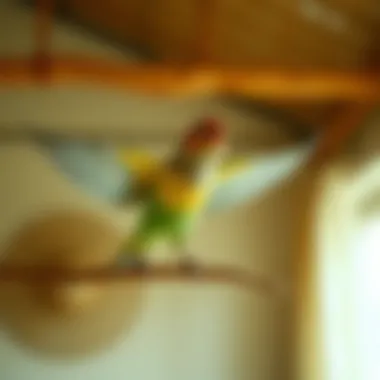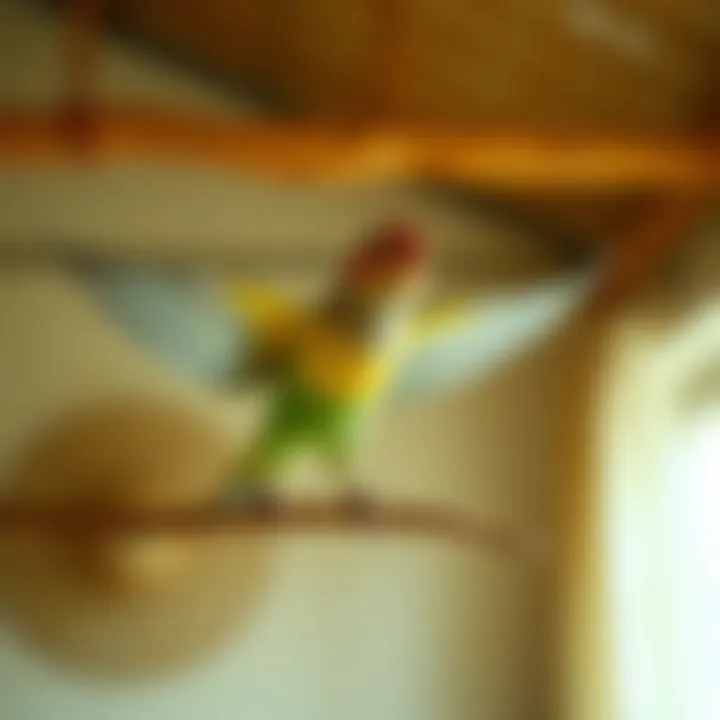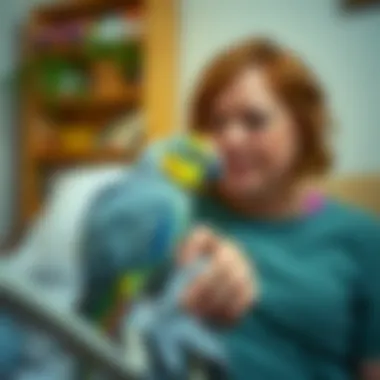Key Considerations for Keeping Birds in Your Bedroom


Intro
Housing a pet bird in your bedroom can create a unique environment that fosters companionship, but it's crucial to take several factors into account. While it may seem cozy to share your personal space with a feathered friend, understanding the nuances involved is essential for both bird and human wellbeing. This guide will navigate you through the principles of maintaining an avian habitat within your bedroom, addressing practical care considerations and the dynamics that come into play when bringing a bird into such an intimate area.
Avian Care Basics
Importance of Proper Nutrition
A well-rounded diet is the cornerstone of avian health. Different species require specific nutrients, so knowing what to feed your bird is paramount. For instance, parrots thrive on a varied diet of pellets, fresh fruits, and vegetables, while canaries prefer a seed-based diet supplemented with greens. Keeping an eye on portion sizes is also essential, as obesity can lead to serious health issues.
Understanding Bird Species and Their Needs
Birds are not one-size-fits-all creatures; each species exhibits unique traits and behaviors. For example, budgies are social and need ample interaction, whereas cockatiels may enjoy a bit more solitude. Identifying your bird's personality can help tailor their environment and daily routines to suit their preferences, making it easier to ensure their happiness and health.
Basics of Birds Habitat Setup
The arrangement of your bird’s habitat plays a pivotal role in their quality of life. Make sure their cage is spacious enough to allow for movement and play. Incorporating perches at various heights, toys for stimulation, and safe spaces for retreat can foster a more enriching atmosphere. Furthermore, strategically placing the cage near areas where they can observe daily household activity can help your pet feel connected without being overwhelmed.
Grooming and Hygiene Tips
Regular grooming is vital, ranging from nail trimming to occasional bathing. Maintaining a clean environment not only keeps your bird healthy but also prevents the buildup of bacteria and odors. Use bird-safe cleaning products, and establish a routine that suits both your schedule and your bird's needs.
Interacting with Your Pet Bird
Building Trust and Connection
Establishing a bond with your bird takes patience. Begin by speaking softly and spending time near their cage. Gradually, you can introduce the idea of handling them. Building trust can lead to more meaningful interactions and a deeper relationship.
Training Techniques and Tips
Training isn't just about teaching your bird to talk or do tricks; it can help nurture their mental well-being. Positive reinforcement, using treats as rewards, often leads to more successful training sessions. Consider simple commands and behaviors to start, like recalling or mimicking sounds.
Fun Activities for Bird Owners and Their Birds
Engaging your bird in activities brings life into both your day and theirs. Simple games like hide-and-seek, where you hide treats, or making homemade toys can create lasting memories. Encourage exploration by placing toys outside of the cage as well.
Recognizing Bird Cues and Behaviors
Every bird communicates differently. Recognizing their body language is essential in understanding their moods and needs. A puffed-up appearance may signal relaxation, while ruffled feathers could indicate discomfort. Learning these signs helps tailor your interactions effectively.
Emotional Well-Being of Birds
The Role of Play and Socialization
Just as humans seek companionship, birds thrive on social interaction and play. Scheduling time to engage with your bird can enhance their emotional well-being. Social birds often require more interaction, so it's important to establish regular bonding sessions.
Enhancing Birds' Emotional Health
Variety in their environment—from toys to human interaction—can significantly improve your bird's emotional state. Consider rotating toys to prevent boredom and encourage exploration. Positive experiences can shape a more confident and less stressed pet.
Assessing Bird Stress and Remedies
Birds can be sensitive to changes in their environment. Notice signs of stress, such as excessive screeching or feather plucking. Providing a calming space with consistent routines can help alleviate anxiety. It might also help to consult with an avian veterinarian for tailored advice when needed.
Building Strong Human-Bird Bonds
Creating a nurturing environment strengthens the bond you share with your bird. Regular communication and understanding their individual needs can yield a lasting friendship. Positive interactions over time will solidify your bird's trust and comfort in their home.
Bird Health and Safety
Common Health Issues and Prevention
Stay alert for common health issues, such as respiratory problems or feather diseases. Routine check-ups with a vet who specializes in avian care can catch early signs and keep your pet thriving.
Routine Veterinary Care
Scheduling regular veterinary visits is non-negotiable in bird care. The vet can provide vaccinations, health assessments, and advice tailored to your pet's specific needs. Building a relationship with an experienced veterinarian can help both you and your bird feel more secure.
Environmental Hazards to Avoid
Birds are curious creatures that often explore their surroundings. It's critical to eliminate potential hazards, such as toxic plants or harmful household items. Ensure your bedroom is free from items like cigarette smoke or candles, which can pose threats to your bird's health.
Signs of Illness or Distress
It's important to be vigilant about subtle signs of illness or distress in your pet. Loss of appetite, lethargy, or changes in droppings can indicate trouble. If you notice anything out of the ordinary, don’t hesitate to consult a veterinarian right away.
Fun Facts and Quirky Insights
Unique Traits of Popular Bird Species
Different bird species boast unique traits that make them stand out. For example, African Grey parrots are known for their remarkable intelligence, often surprising their owners with their mimicry and problem-solving skills. Understanding these traits adds depth to the experience of bird ownership.
Historical and Cultural Significance of Birds
Birds have played significant roles throughout history, often symbolizing freedom and joy. In various cultures, they embody messages, such as peace doves in Christianity or even as deities in ancient Egyptian mythology.


Famous Bird Owners and Their Stories
Celebrities like Ellen DeGeneres and her beloved cockatoo have highlighted the joy of bird parenting. Their stories showcase the connections people can have with their feathered friends, often filled with warmth and rich experiences.
To dive deeper and explore more about avian care, consider visiting resources like the American Birding Association or BirdLife International. Their knowledge can help enrich your bird-keeping journey.
Prolusion to Pet Birds in the Bedroom
Keeping a pet bird in your bedroom can indeed be a rewarding yet challenging decision. It’s not just about having a feathered friend nearby; it's a commitment that involves understanding their needs and the environment in which they thrive. Choosing the bedroom as a habitat for your avian companion presents both advantages and potential pitfalls. This article provides a comprehensive look at what it means to house birds in your bedroom, exploring necessary considerations around safety, companionship, and care routines. By delving into these aspects, we aim to give current or aspiring bird owners a solid foundation for creating a nurturing space that supports their pets’ wellbeing.
Why Choose the Bedroom for Bird Housing
One might wonder why someone would opt to keep birds in a bedroom. The answer often lies in convenience and comfort. Bedrooms are personal spaces, frequently allowing for more intimate interactions. The physical proximity can promote bonding; noticing your bird's antics first thing in the morning sets a positive tone for the day.
However, the decision is not solely about aesthetics or convenience. Birds are smart and social creatures. A bedroom environment can be quieter compared to other rooms in the house, which can help reduce stress for the bird. For parakeets or cockatiels, this reduced stimulation can translate to a healthier and happier life.
Yet, with every silver lining comes a cloud. Not all bedrooms offer the healthiest environment for our feathered friends. Things like air quality, natural light, and even how often you clean the room can influence your decision. It’s crucial to assess how your specific situation might affect your bird's health and happiness before moving forward.
Understanding the Unique Dynamics of Avian Companionship
Birds aren't just pets; they can become cherished companions, often developing unique bonds with their human caregivers. Each bird species comes with its own behavioral quirks, which means that understanding these personalities is key to fostering a harmonious atmosphere.
For instance, while some birds relish in the peaceful confines of their cages, others might grow restless. Recognizing when your bird craves interaction can lead to mutual satisfaction—you're not just another member of the household; you’re their buddy. This dynamic often enhances the experiences of both the owner and the bird, making it a two-way street.
Birds also communicate differently than other pets. They use vocalizations, body language, and even mimicry. For example, a cockatiel may whistle when it feels playful or approach you with its feathers slightly puffed up to indicate affection. Knowing these cues can dramatically improve the relationship.
Thus, the dynamics of avian companionship encompasses much more than merely sharing space. At their core, these relationships hinge upon mutual trust, understanding, and care—qualities that foster an enriching environment for both you and your feathered friend.
Environmental Considerations
When it comes to housing a pet bird in your bedroom, environmental considerations are crucial in shaping a harmonious relationship between you and your avian companion. Your bird’s habitat should not only be safe but also conducive to its overall well-being. This section dives into the elements that you must keep an eye on to ensure a suitable living environment for your feathered friend.
Assessing Bedroom Safety
Assessing safety in your bedroom is the backbone for a thriving bird environment. Safety encompasses a range of factors, from understanding potential hazards to ensuring your room is a secure haven. Birds, being naturally curious, will explore their surroundings, which is why it’s essential to remove or modify anything that could pose a threat. A safe bedroom leads to a happier bird and a more relaxed owner. Key things you might consider include:
- Secure window screens to prevent escape.
- Cover hot surfaces like radiators.
- Ensure that any ceiling fans are off when the bird is out of the cage.
Keeping your bird within a safe area helps nurture their exploration spirit without risking injury.
Recognizing Potential Hazards
Birds are smaller and more fragile compared to many pets, making awareness of potential hazards even more essential in bedroom settings. Here are several elements to consider:
Ventilation Issues
Ventilation is often overlooked. A good airflow can help dispel any potential harmful particles and stale air, creating a healthier environment for your feathered friend. Stagnant air might carry dust and other allergens which can affect your bird's respiratory health. It’s beneficial to open windows regularly or use air purifiers designed for small spaces. The unique characteristic here is that good ventilation is not just about comfort; it forms the basis of their well-being. However, too much draft can be detrimental; hence, finding a balance is key. An adequately ventilated room prevents the buildup of harmful bacteria or air pollutants that could compromise your bird's health, ensuring that they live in a conducive environment where they can thrive.
Toxic Household Items
Household items that may seem harmless can be toxic to birds. Things like scented candles, non-stick cookware, and certain cleaning agents can release fumes that are devastatingly harmful to your pet. It’s worth highlighting that many people might not even be aware of the dangers lurking around their homes. Thus, opting for bird-safe cleaning products and ensuring proper storage of hazardous items is crucial. The unique challenge lies in the fact that these items are often routinely used, making it easy to overlook them. Hence, conducting a thorough audit of your home could save your bird life.
Noise Pollution
Noise pollution is another concern that shouldn’t be brushed aside. Birds have sensitive hearing and excessive loud sounds can cause stress and anxiety. Consider how sound travels in your space. If your bedroom is closely adjacent to more boisterous areas, these environmental sounds could disturb your bird. Regular noises from television, stereo systems, or even household appliances can affect your bird's behavior and well-being. It’s a supportive choice in this article because understanding how noise pollution impacts birds encourages you to make room adjustments or sound-proofing decisions to ensure a quieter atmosphere for your bird companion. By reducing unnecessary noise, you are fostering a calming environment, which in turn promotes a more positive interaction with your feathered friend.
By addressing these environmental considerations, you can create a bedroom space that not only nurtures your pet bird’s needs but also enhances your interaction and bond with them. Making conscious decisions about safety, hazard recognition, and environmental health play essential roles in cultivating a thriving living condition.
Psychological Impact on Birds
Understanding the psychological effect of keeping a bird in the bedroom is key for both the well-being of the avian pet and the owner. Birds, being social creatures, have unique emotional and mental needs that must be addressed. Their environment plays a crucial role in shaping their behavior and overall health. Keeping a bird in a bedroom setting can have significant effects, and it’s essential to recognize these dynamics.
Stress Reduction in Personal Spaces
A bedroom, often considered a personal sanctuary, can be a calming haven for birds. This familiar space may offer a sense of security and comfort. When a bird feels safe, the potential for stress noticeably diminishes. Stress reduction is vital for various reasons:
- Lower Stress Levels: A calm environment helps in lowering anxiety. Birds that are anxious may undergo behavioral changes, leading to issues such as feather plucking or loud vocalizations.
- Improved Mental Health: Just like humans, birds can experience depression or anxiety. The serene nature of a bedroom can help in mitigating such issues.
- Bonding Opportunities: A relaxed environment fosters stronger connections between the bird and its owner. Positive interactions can thrive when neither party feels rushed or agitated.
To create a stress-free atmosphere:
- Soft Lighting: Consider using soft or dim lighting to create a soothing ambiance.
- Flutter-Free Zone: Limit the movement around the cage and avoid sudden movements.
- Quiet Hours: Establish times when the room is quiet, allowing the bird to rest without disturbance.
Monitoring Behavioral Changes
Keeping a close eye on your bird's behavior is essential, especially if it lives in your bedroom. Birds often communicate how they feel through their actions. Regular observation helps in noticing any shifts that may indicate psychological distress or emotional well-being. Here are some notable behavioral cues:
- Vocalization Patterns: An increase or decrease in chirping can signal stress or comfort. Pay attention to your bird's unique sounds.
- Activity Levels: A sudden change in energy can indicate various issues. Lack of activity might mean the bird is feeling down, while excessive chatter could suggest a need for attention.
- Feeding Habits: Reduced interest in food can be a sign of stress or illness. Conversely, a healthy appetite can mean your bird is thriving.
Monitoring includes:
- Journaling Daily Notes: Keeping a log of your bird’s behavior can provide insights over time.
- Observing Social Interactions: How does your bird interact with you and possibly with other pets? Watch for aggression or retreating behavior.
- Adjusting Environment: If you notice behavior changes, consider adjusting the environment. For instance, placing a favorite toy, changing the cage's location, or tweaking the routine can help.
"Being aware of subtle changes in behavior can lead to early intervention, averting potential health issues before they escalate."
Understanding these important psychological aspects not only enhances your bird's quality of life but strengthens your companionship. By creating a thoughtful and responsive living space in your bedroom, you cater to your bird’s mental health while enriching the relationship you share. This intricate bond, rooted in patience and observation, promises a fulfilling experience for both parties.


Practical Care Considerations
In the world of pet birds, practical care considerations are paramount. While many folks might view a bird as a low-maintenance pet, the reality is a bit more complex. Keeping a bird in the bedroom means being aware of its needs in a personal space. The right approach to feeding, watering, and maintaining cleanliness can not only enhance your bird's quality of life but also foster a deeper bond.
Feeding and Watering Strategies
Creating a balanced diet for pet birds might look simple on the surface, but it comes with its own quirks and requirements. It's important for bird owners to realize that different species have different dietary needs. For instance, a parakeet's diet might focus heavily on seeds and pellets, whereas a cockatiel might benefit from fruits and veggies.
When setting up feeding stations in the bedroom, keep these points in mind:
- Quality Over Quantity: Invest in high-quality pellets that are fortified with essential vitamins and minerals. Avoid low-grade seed mixes, which often lack nutritional value.
- Fresh is Best: Offering fresh fruits and veggies daily can be a game-changer for your bird’s health. Just be sure to wash them to eliminate any pesticides or chemicals.
- Water Matters: Always provide a clean source of water. Change it daily to keep it fresh. Some birds may prefer a shallow dish, while others might do better with a water bottle.
Establish a routine for feeding that aligns with your schedule. Birds thrive on consistency, so whether it’s breakfast time or dinner time, make sure they know when to expect their meals. Keeping a food journal can help you monitor what your bird eats, as well as any preferences or aversions.
Cleaning Routine in the Bedroom Environment
Cleaning isn’t just about aesthetics; it plays a crucial role in your bird's well-being. A clean environment can drastically reduce the risk of health issues and ensure a pleasant living space. Here are some points to help guide your cleaning routine:
- Daily Spot Checks: Look out for any leftover food, feather dust, or droppings. Spot-cleaning these areas daily helps keep your bird’s area tidy.
- Deep Cleaning: Aim for a full clean of the bird’s space at least once a week. This should include disassembling their cage, washing the perches and toys, and replacing the bedding or liners with fresh material.
- Choose Safe Products: When it comes to cleaning supplies, prioritize bird-safe products. Vinegar and water can be an effective and non-toxic option for most surfaces. Avoid bleach or harsh chemicals, which can be toxic for birds.
"A clean environment is the first step toward a healthy pet."
For those looking to delve deeper into pet bird care, consider visiting resources like The Avian Society or checking out various forums on Reddit for firsthand experiences and advice.
Fostering Emotional Bonds
Fostering emotional bonds with your pet bird is not just a warm and fuzzy notion; it's a cornerstone of avian companionship that significantly enhances both the life of the bird and the owner. Birds, unlike some pets, require a unique approach to building relationships that go beyond simple feeding and care. When a bird feels secure and valued, it is much more likely to thrive in its environment—especially one like the bedroom where human emotions intertwine.
Understanding Bird Behavior and Interactions
Birds communicate primarily through body language and vocalizations, and understanding these signals is key to developing a deep connection. Each species behaves differently, and even individual birds within the same species may have their own quirks. A parakeet might bob its head excitedly when it sees you, while a cockatoo may prefer to sidle closer to you and preen your hair as a sign of affection.
Some important aspects to consider include:
- Observation: Spend time watching your bird during its routines. Notice how it interacts with toys or reacts to sounds. This observation can help in recognizing when the bird is happy or stressed.
- Response: When your bird engages in specific behaviors, respond with gentle words or positive reinforcement. This can help them associate you with positive experiences.
- Time: Dedicate specific times for interactions, be it through gentle conversation or play. Birds thrive on routine, and having a consistent interaction schedule can strengthen your bond.
Not only does understanding their behavior help, but it can also prevent misunderstandings that may lead to stress for the bird. When you can interpret a cockatoo's plaintive call or a macaw's playful nip correctly, it makes a world of difference.
Enhancing Communication with Your Bird
Effective communication with a pet bird is a two-way street. Just as you strive to understand their signals, they must learn to understand yours. Establishing this connection can lead to increased trust and an enriched living environment.
Some strategies to improve communication include:
- Consistent Sounds: Use specific sounds or phrases that your bird can learn to identify. For instance, saying "Good morning!" each time you approach the cage can signal to your bird that it's time for interaction.
- Body Language Cues: Birds are perceptive to body language. Lean into their space or extend your hand slowly and gently, giving them cues that you mean no harm. This can encourage them to respond positively.
- Interactive Toys: Incorporate toys that encourage interaction. Toys that make noise can stimulate conversation; many birds enjoy "talking" to their toys as much as to their owners.
Communication can be especially important during moments of stress. If a bird seems anxious, integrating calming words or playing soothing sounds can help bridge the gap between you and your feathered friend.
"Building a meaningful connection with your pet bird can transform the way you both experience life together, establishing a bond that transcends simple caretaking."
In summary, fostering emotional bonds with your bird involves understanding their behavior, enhancing communication, and being present in their daily lives. This attentiveness not only aids in nurturing a long-lasting relationship but also enriches the overall experience of being a pet owner.
Creating a Stimulating Environment
Providing a stimulating environment for a pet bird in the bedroom is vital for their overall well-being. Birds are intelligent creatures that require mental engagement and physical activity to thrive. Beyond just a cage, they need to interact with their surroundings, explore, and exhibit natural behaviors. A lack of stimulation can lead to boredom and stress, negatively affecting their mental health and happiness. This part discusses how to create a vibrant space for your feathered companion.
Choosing Appropriate Toys and Enrichment Activities
Selecting the right toys and activities is crucial. Birds enjoy toys that can be chewed, swung, or climbed on. Here is a list of some options:
- Chew Toys: Natural wood, leather, or paper toys give them something to gnaw on and keep their beaks healthy.
- Swing and Climbing Structures: Offering diverse perches and climbing opportunities encourages physical activity and exploration.
- Interactive Toys: Puzzle toys or treat dispensers stimulate their minds, making for an engaging experience.
- Mirrors: While these can be hit or miss with different birds, many enjoy interacting with their reflections.
When choosing toys, it's essential to consider the size and species of your bird. Larger birds need sturdier toys, while smaller species favor softer items. Rotate toys regularly to keep them fresh and enticing. This also prevents them from becoming overly attached to one thing, which can lead to boredom.
For enrichment activities, consider spending time directly interacting with your bird. Teaching them tricks or allowing them to explore safe areas of the bedroom can provide both mental and physical stimulation.
Utilizing Space Efficiently
Space isn't just about square footage; it’s how you use it. Birds love to perch, play, and fly, so maximizing the usable space is beneficial. Here are some ways to utilize your bedroom effectively:
- Vertical Space: Birds don't always need a large floor area, but having multiple levels and varying heights where they can land is important. If you can install shelves or have tall stands, your bird will appreciate the extra vertical territory.
- Playstands: A dedicated play area outside the cage can help to break up their day. Invest in a playstand that can hold toys, food, and even a cozy spot to perch. This diversifies their environment and helps keeps boredom at bay.
- Cage Placement: Place the cage where your bird can see and interact with the household activity, but ensure it's not in a direct draft or in the sun for long periods. They like to feel included but also need their quiet time.
- Safe Zones: Creating areas with safe items they can explore boosts their curiosity. Non-toxic plants or bird-safe materials can enhance the ambiance while being safe for your feathery friend.
Creating a vibrant environment goes beyond aesthetics; it nurtures the mental and physical health of our avian companions.
For more about enhancing your bird's living space, visit BirdChannel or check out resources like PetMD.
Assessing the Compatibility of Your Bird
Keeping a pet bird in your bedroom comes with its own set of challenges and joys. One of the more critical aspects that needs contemplation is the compatibility between the bird you select and your lifestyle. Not every bird is suited to the same environment or routine. This section will elaborate on why assessing this compatibility is essential for both your well-being and your feathered friend’s happiness.
Evaluating Species-Specific Traits
Each species of bird possesses unique characteristics that can heavily influence how well they adapt to living in a bedroom. Colorful parakeets, for instance, are known for their sociable nature, making them delightful companions. They thrive on interaction, so a bedroom shared with a busy human may serve them well.
In contrast, a cockatoo, while equally charming, has a reputation for being loud and demanding considerable attention. If your routines are filled with quietude, such a bird might disrupt the tranquility you seek in your personal space.


To evaluate the species-specific traits, consider:
- Size: The dimensions of your room may dictate the size of the bird. A large macaw requires ample space compared to a small finch.
- Temperament: Some birds are known to be more skittish, while others can be exceptionally bold. Knowing your bird’s temperament can significantly affect bonding and comfort levels.
- Vocalization: Different species have varying vocal tendencies. Research the likely noise levels so you aren’t caught off guard.
Before making a commitment, it may be wise to spend time interacting with the species you’re considering to gauge their traits in person.
Considering Social Needs and Behavior
Birds, regardless of species, have inherent social needs. They are not solitary creatures by nature. Understanding these social aspects can greatly enhance the relationship between you and your feathered companion.
Many birds, like conures, require frequent interaction and engagement. If you’re frequently busy or away, it can lead to anxiety and frustration for the bird. Likewise, observing how birds interact in their natural habitats can provide insights into their social behavior.
Key considerations include:
- Friendliness with Humans: Some species are known for their adaptability and friendly demeanor towards humans, while others may take more time or show a degree of wariness.
- Need for Companionship: Certain birds thrive when kept in pairs or groups. A lone bird can become lonely and develop health issues, leading to destructive behavior.
- Interactive Play: Birds often enjoy playtime, which can be facilitated through toys, interactive games, or simple bonding exercises.
In the end, the aim is to create a balance. Your lifestyle should complement the bird's social needs, promoting a secure, comfortable environment. Caring for a bird is a two-way street, and ensuring compatibility will foster a fulfilling companionship.
“In the realm of avian companionship, compatibility isn't just a preference; it’s a imperative for harmony.”
Choosing wisely not only enhances the living conditions for your bird but also enriches your own life. It’s a commitment that can lead to years of joy, teaching both you and your bird the art of living together in harmony.
Socializing Your Bird Effectively
Socialization plays a crucial role in fostering a healthy bond between your feathered friend and yourself. Birds, inherently sociable creatures, require interaction to thrive. Keeping a pet bird in the bedroom presents a unique opportunity to integrate your bird into your daily life. Properly socializing your avian companion not only nurtures their emotional well-being but also enhances your own enjoyment of their company.
Birds can display a range of behaviors depending on their species and individual personality traits. Effective socialization helps to reduce fears and anxieties that your bird may have, especially when they reside in a space filled with unfamiliar sounds and sights. Establishing a functional routine centered around interaction can ease your bird into this new environment with confidence.
Integrating the Bird into Daily Routines
Birds thrive on routine. By incorporating your pet into your daily activities, you not only help them feel more at home but also create a cohesive bond that can last a lifetime. You might start with short interactions, like spending a few minutes with your bird while drinking your morning coffee, letting them observe your actions and hear the familiar sounds of your routine. Here are a few practical ways to integrate your bird into daily life:
- Morning Chats: Speak softly to your bird each morning as part of your wake-up routine. This voice exposure is comforting and helps to build familiarity.
- Mealtime Together: Consider placing your bird near your dining area during meals. Share stories too about your day while you eat; the sounds and vibrations can intrigue them and foster a sense of inclusion.
- Training Sessions: Engaging your bird in simple training activities, like learning to perch on your finger, introduces positive structures and creates moments of trust and fun.
Each day provides fresh chances to nurture your bond. Over time, these actions can lead to your bird developing a more relaxed demeanor, allowing them to feel less like a stranger in your bedroom.
Facilitating Positive Interactions with Other Pets
If you have other pets, socializing your bird with them requires careful planning and consideration. Birds may view other animals as either threats or potential friends, so the introduction must be handled delicately. Start by keeping the birds and other pets separated physically, yet allow them to hear each other’s noises. This can create curiosity and lessen the intimidation factor of meeting face to face.
When the time feels right:
- Supervised Meetings: Introduce them in a controlled setting, using a cage for the bird. This way, the other pet can become accustomed to the bird's presence while remaining safe.
- Positive Reinforcement: Reward both your bird and the other pet for calm behavior during these meetings. Treats can work wonders in reshaping responses to one another.
- Gradual Freedom: Once these interactions are normalized, consider allowing supervised free range time where they can explore together while being closely monitored to prevent any mishaps.
Remember, not all pets are compatible. Watch for signs of stress, aggression, or fear in both your bird and other pets. It’s essential to be flexible and patient, adapting the plan as necessary.
Through effective socialization, you create a harmonious living space in your bedroom that benefits both you and your pet bird. In addition to enhancing their behavioral patterns, socializing fosters a loving, welcoming environment for your avian companion, allowing them to thrive.
Addressing Common Challenges
Keeping a pet bird in the bedroom can seem like a delightful arrangement, but such a setup isn’t without its hurdles. Tackling potential challenges is a necessary part of ensuring the well-being of both your feathered friend and yourself. Let’s dive into the common issues you might face.
Dealing with Noise Concerns
Birds, being naturally vocal creatures, can create a cacophony that might disrupt your peace. It's important to recognize that each species has its own vocal tendencies. For example, cockatiels may love to whistle, while parakeets engage in constant chatter. To manage this noise factor, consider investing in soundproofing your bedroom.
Here are a few strategies to mitigate noise:
- Creating quiet hours: Establish specific times during the day when it's best to keep things calm. This will not only help you but will also be comforting for your bird.
- Scheduling bird playtime earlier: Birds tend to be more active in the morning. Engaging them early might divert their energy away from making noise later on.
- Providing distractions: Toys or activities can keep your bird entertained, reducing the need for constant vocalization.
Finding a balance with noise can help maintain harmony in your home, making it livable for both you and your pet.
Managing Allergies and Health Issues
Allergies can pose a real threat in a shared living space. Even if you've never had issues before, feathers and dander might trigger reactions. Taking preventative measures can be crucial for both your health and your bird's well-being. Regular cleaning is a must. Here’s how you can keep allergies at bay:
- Regular cage cleaning: Clean their habitat frequently to manage dander build-up. Use safe, non-toxic cleaners to keep both you and your bird healthy.
- Air purification: Using air purifiers can significantly lower airborne allergens. Look for HEPA filters which are particularly adept at filtering out small particles.
- Humidity control: Maintaining appropriate humidity levels can help lessen allergy symptoms. Too dry, and the dander can float; too humid, and dust mites may thrive.
Additionally, monitoring your bird's health is essential. If you notice changes in their behavior or health, consulting an avian vet should be your next step. You might not think a tiny bird could contribute to health problems, but the reality is they can impact air quality, especially if proper care considerations aren't met.
By addressing these common challenges, you can foster a more pleasant living environment—making your bedroom a safe and joyful sanctuary for both you and your avian companion. Remember that each issue enhances your understanding of what it takes to maintain a harmonious coexistence.
Epilogue
In wrapping up the discussion regarding the considerations of maintaining a pet bird in the bedroom, it's essential to reflect on several integral aspects that influence not only the bird's well-being but also the dynamics of the human-animal relationship. Keeping a bird in this personal space can be deeply rewarding, fostering a unique bond between the owner and their feathered friend. However, it’s not without a fair share of challenges and responsibilities.
Recap of Important Considerations
Some key considerations highlighted through this article include:
- Environmental Safety: The bird's living space must be safe and secure. Ensuring that hazardous items are out of reach and proper ventilation is present can safeguard the bird's health.
- Psychological Well-Being: Observing the bird's behavior helps in recognizing stress signals and adjusting the environment as needed. A peaceful setting can improve both the bird's mood and the owner’s experience.
- Practical Care: Establishing feeding schedules, cleaning routines, and enriching activities goes a long way in enhancing the birds' quality of life. Regular attention to their dietary needs and habitat cleanliness is vital.
- Compatibility and Communication: Knowing your bird’s social needs and nurturing effective communication can significantly boost interactions and bond-building.
Keeping these factors in mind allows bird owners to address potential challenges proactively, ensuring the bedroom remains a sanctuary for both the bird and its human companion.
Final Thoughts on Bedroom Avian Companionship
Ultimately, the choice to house a pet bird in the bedroom is a significant one and merits thorough consideration. This environment not only serves as a resting space for birds but also as a rich ground for human-bird interaction. It asks for a commitment that extends beyond mere companionship.
By recognizing the unique needs and characteristics of your avian companion, coupled with a sincere dedication to creating a harmonious living space, one can enjoy the profound joy and satisfaction that owning such a pet entails.
"Keeping a bird in your space is more than just sharing a room; it's about sharing lives."
To delve deeper into specific behavioral aspects and care methods, resources such as The Bird Channel, National Wildlife Federation, and PetMD can be invaluable. Understanding these dimensions not only elevates the experience but also enriches the lives of both birds and their caregivers.















